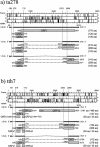Isolation of multiple TT virus genotypes from spleen biopsy tissue from a Hodgkin's disease patient: genome reorganization and diversity in the hypervariable region
- PMID: 15220423
- PMCID: PMC434092
- DOI: 10.1128/JVI.78.14.7498-7507.2004
Isolation of multiple TT virus genotypes from spleen biopsy tissue from a Hodgkin's disease patient: genome reorganization and diversity in the hypervariable region
Abstract
We report the isolation of 24 novel genotypes of TT viruses from a surgically removed spleen of a patient with Hodgkin's disease. The sequence analysis of our 24 isolates revealed the remarkable heterogeneity of TT virus isolates not only from the same patient but also from the same biopsy material. These isolates belong to four phylogenetic groups of TT viruses. Nucleotide sequence analyses revealed five distinct genotypes (tth3, tth4, tth5, tth6, and tth7). The limited variation in sequence identity of the other isolates defines the latter as variants of four of these genotypes. A group of 6 isolates (the tth7 group) revealed a reorganization of open reading frame 1 (ORF1) leading to one larger and a varying number of smaller ORFs. The nucleotide difference of the full-length genomes was less than 1%. A variation of 69 to 97% in amino acids of a second group of 8 isolates (the tth3 group) was restricted to the hypervariable region of ORF1, indicating the existence of a quasi-species. These isolates differed by less than 2% in the remainder of their nucleotide sequences. An alignment of these isolates with 79 previously reported TT virus genotypes permits the proposal of TT virus genera and species within the family Anelloviridae in analogy to a previous proposal for the papillomaviruses (family Papillomaviridae).
Figures





Similar articles
-
Full or near full length nucleotide sequences of TT virus variants (Types SANBAN and YONBAN) and the TT virus-like mini virus.Intervirology. 2000;43(2):119-23. doi: 10.1159/000025034. Intervirology. 2000. PMID: 10971131
-
In vivo and in vitro intragenomic rearrangement of TT viruses.J Virol. 2007 Sep;81(17):9346-56. doi: 10.1128/JVI.00781-07. Epub 2007 Jun 27. J Virol. 2007. PMID: 17596318 Free PMC article.
-
Novel variants related to TT virus distributed widely in China.J Med Virol. 2002 May;67(1):118-26. doi: 10.1002/jmv.2200. J Med Virol. 2002. PMID: 11920826
-
TT virus infection: a novel virus-host relationship.J Med Microbiol. 2002 Jun;51(6):455-458. doi: 10.1099/0022-1317-51-6-455. J Med Microbiol. 2002. PMID: 12018651 Review. No abstract available.
-
Classification of TTV and related viruses (anelloviruses).Curr Top Microbiol Immunol. 2009;331:21-33. doi: 10.1007/978-3-540-70972-5_2. Curr Top Microbiol Immunol. 2009. PMID: 19230555 Review.
Cited by
-
Torque Teno Virus: Lights and Shades.Viruses. 2025 Feb 27;17(3):334. doi: 10.3390/v17030334. Viruses. 2025. PMID: 40143262 Free PMC article. Review.
-
Epstein-Barr virus stimulates torque teno virus replication: a possible relationship to multiple sclerosis.PLoS One. 2012;7(2):e32160. doi: 10.1371/journal.pone.0032160. Epub 2012 Feb 22. PLoS One. 2012. PMID: 22384166 Free PMC article.
-
Metagenomic sequencing reveals time, host, and body compartment-specific viral dynamics after lung transplantation.Microbiome. 2022 Apr 23;10(1):66. doi: 10.1186/s40168-022-01244-9. Microbiome. 2022. PMID: 35459224 Free PMC article.
-
Phylogenetic analysis of torque teno virus in Romania: possible evidence of distinct geographical distribution.Arch Virol. 2022 Nov;167(11):2311-2318. doi: 10.1007/s00705-022-05559-8. Epub 2022 Aug 13. Arch Virol. 2022. PMID: 35962263 Free PMC article.
-
Taxonomic Changes for Human and Animal Viruses, 2018 to 2020.J Clin Microbiol. 2021 Jan 21;59(2):e01932-20. doi: 10.1128/JCM.01932-20. Print 2021 Jan 21. J Clin Microbiol. 2021. PMID: 32848040 Free PMC article. Review.
References
-
- Cacoub, P., E. Rosenthal, V. Gerolami, P. Hausfater, P. Ghillani, Y. Sterkers, V. Thibault, H. Khiri, J. C. Piette, and P. Halfon. 2003. Transfusion-associated TT virus co-infection in patients with hepatitis C virus is associated with type II mixed cryoglobulinemia but not with B-cell non-Hodgkin lymphoma. Clin. Microbiol. Infect. 9:39-44. - PubMed
-
- Cong, M., B. Nichols, X. Dou, J. E. Spelbring, K. Krawczynski, H. A. Fields, and Y. E. Khudyakov. 2000. Related TT viruses in chimpanzees. Virology 274:343-355. - PubMed
-
- de Villiers, E.-M. 2001. Taxonomic classification of papillomaviruses. Pap. Rep. 12:57-63.
MeSH terms
Associated data
- Actions
- Actions
- Actions
- Actions
- Actions
- Actions
- Actions
- Actions
- Actions
- Actions
- Actions
- Actions
- Actions
- Actions
- Actions
- Actions
- Actions
- Actions
- Actions
- Actions
- Actions
- Actions
- Actions
- Actions
- Actions
- Actions
- Actions
- Actions
- Actions
- Actions
- Actions
LinkOut - more resources
Full Text Sources
Other Literature Sources
Medical

